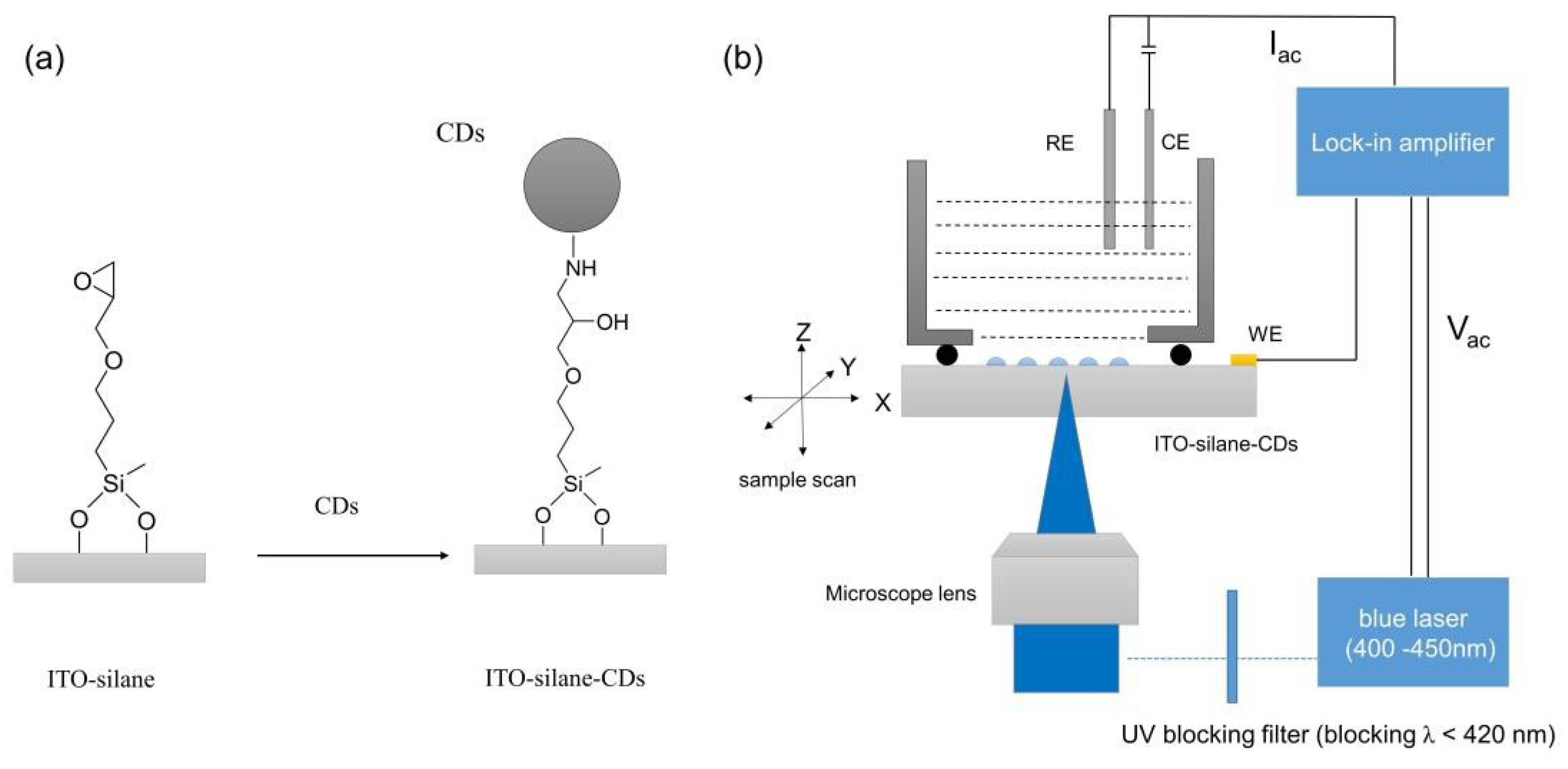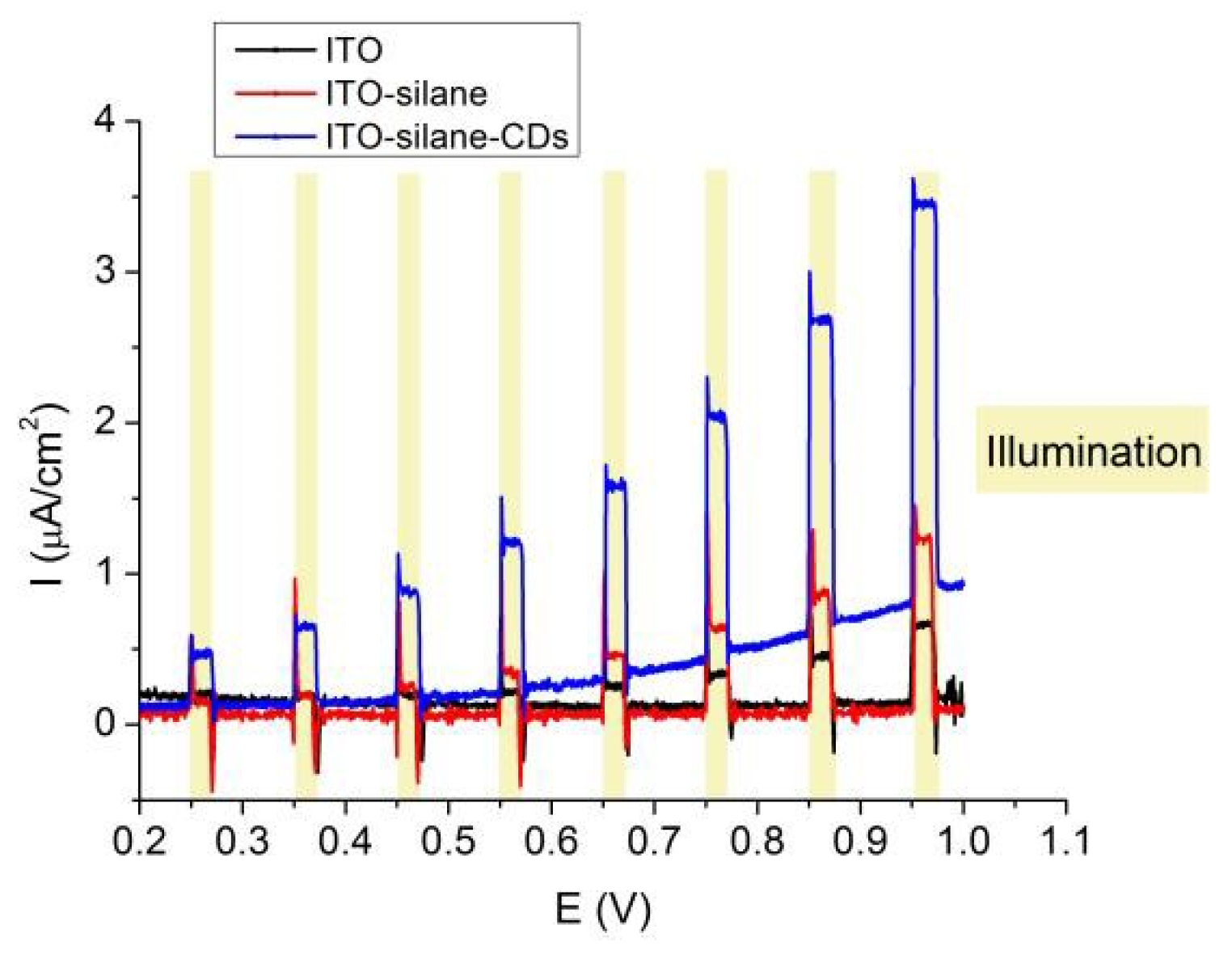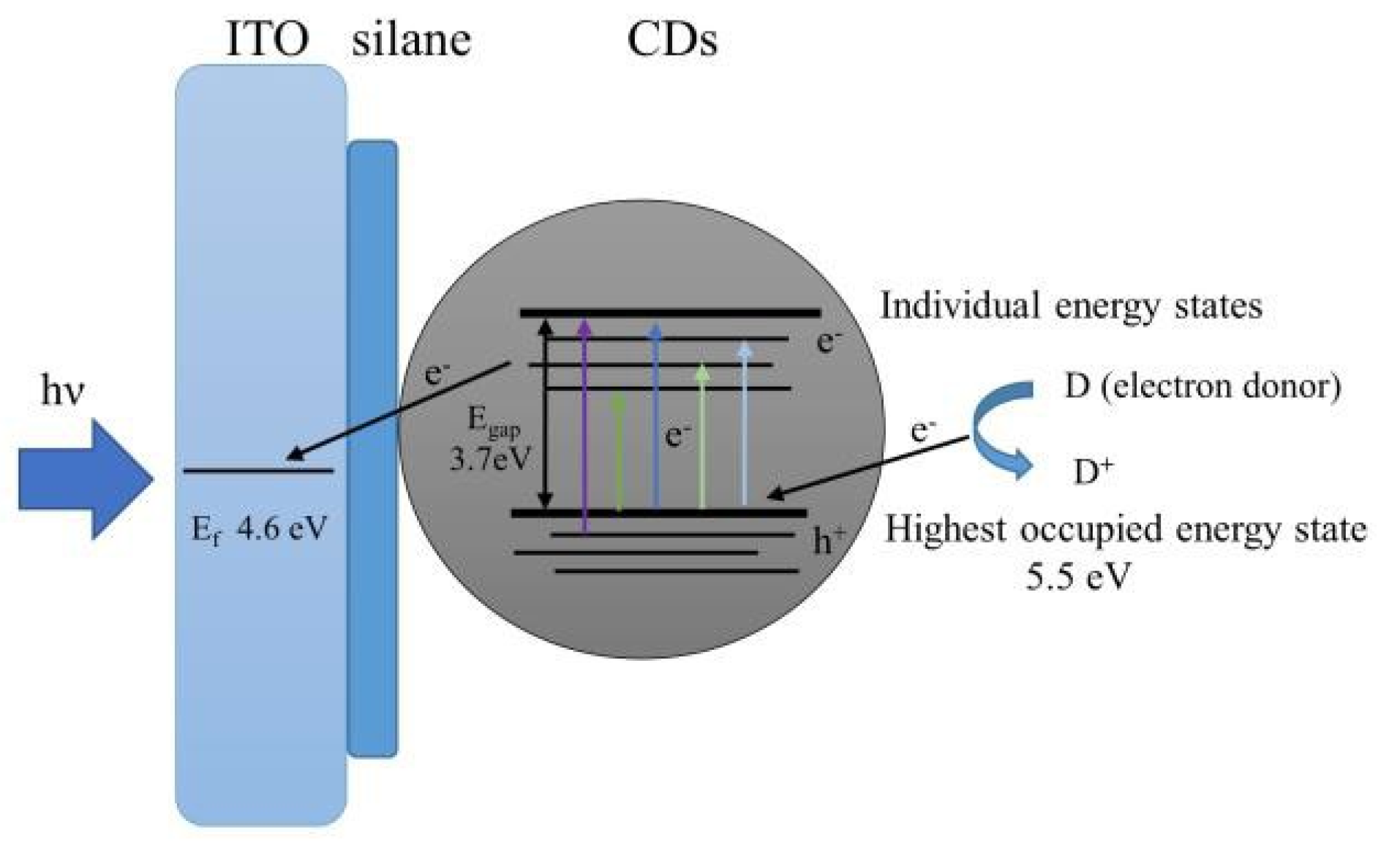Photoelectrochemical Imaging Using Carbon Dots (CDs) Derived from Chitosan †
Abstract
:1. Introduction
2. Materials and Methods
2.1. The Preparation of CDs
2.2. The Preparation of ITO-Silane-CD Surfaces
2.3. Photocurrent Measurements
2.4. AC Photocurrent Imaging
3. Results and Discussion
Author Contributions
Funding
Conflicts of Interest
References
- Yu, H.; Shi, R.; Zhao, Y.; Waterhouse, G.I.N.; Wu, L.-Z.; Tung, C.-H.; Zhang, T. Smart utilization of carbon dots in semiconductor photocatalysis. Adv. Mater. 2016, 28, 9454–9477. [Google Scholar] [CrossRef] [PubMed]
- Bian, J.; Huang, C.; Wang, L.; Hung, T.; Daoud, W.A.; Zhang, R. Carbon dot loading and TiO2 nanorod length dependence of photoelectrochemical properties in carbon dot/TiO2 nanorod array nanocomposites. ACS Appl. Mater. Interfaces 2014, 6, 4883–4890. [Google Scholar] [CrossRef] [PubMed]
- Yu, H.; Zhang, H.; Huang, H.; Liu, Y.; Li, H.; Ming, H.; Kang, Z. ZnO/carbon quantum dots nanocomposites: One-step fabrication and superior photocatalytic ability for toxic gas degradation under visible light at room temperature. New J. Chem. 2012, 36, 1031–1035. [Google Scholar] [CrossRef]
- Zhang, X.; Wang, F.; Huang, H.; Li, H.; Han, X.; Liu, Y.; Kang, Z. Carbon quantum dot sensitized TiO2 nanotube arrays for photoelectrochemical hydrogen generation under visible light. Nanoscale 2013, 5, 2274–2278. [Google Scholar] [CrossRef] [PubMed]
- Yang, K.D.; Ha, Y.; Sim, U.; An, J.; Lee, C.W.; Jin, K.; Kim, Y.; Park, J.; Hong, J.S.; Lee, J.H.; et al. Graphene quantum sheet catalyzed silicon photocathode for selective CO2 conversion to CO. Adv. Funct. Mater. 2016, 26, 233–242. [Google Scholar] [CrossRef]
- Liu, R.; Huang, H.; Li, H.; Liu, Y.; Zhong, J.; Li, Y.; Zhang, S.; Kang, Z. Metal nanoparticle/carbon quantum dot composite as a photocatalyst for high-efficiency cyclohexane oxidation. ACS Catal. 2014, 4, 328–336. [Google Scholar] [CrossRef]
- Khalid, W.; el Helou, M.; Murböck, T.; Yue, Z.; Montenegro, J.-M.; Schubert, K.; Göbel, G.; Lisdat, F.; Witte, G.; Parak, W.J. Immobilization of quantum dots via conjugated self-assembled monolayers and their application as a light-controlled sensor for the detection of hydrogen peroxide. ACS Nano 2011, 5, 9870–9876. [Google Scholar] [CrossRef] [PubMed]
- Zhang, D.-W.; Papaioannou, N.; David, N.M.; Luo, H.; Gao, H.; Tanase, L.C.; Degousée, T.; Samorì, P.; Sapelkin, A.; Fenwick, O.; et al. Photoelectrochemical response of carbon dots (CDs) derived from chitosan and their use in electrochemical imaging. Mater. Horiz. 2018, 5, 423–428. [Google Scholar] [CrossRef]




Publisher’s Note: MDPI stays neutral with regard to jurisdictional claims in published maps and institutional affiliations. |
© 2018 by the authors. Licensee MDPI, Basel, Switzerland. This article is an open access article distributed under the terms and conditions of the Creative Commons Attribution (CC BY) license (https://creativecommons.org/licenses/by/4.0/).
Share and Cite
Zhang, D.; Papaioannou, N.; Titirici, M.-M.; Krause, S. Photoelectrochemical Imaging Using Carbon Dots (CDs) Derived from Chitosan. Proceedings 2018, 2, 778. https://doi.org/10.3390/proceedings2130778
Zhang D, Papaioannou N, Titirici M-M, Krause S. Photoelectrochemical Imaging Using Carbon Dots (CDs) Derived from Chitosan. Proceedings. 2018; 2(13):778. https://doi.org/10.3390/proceedings2130778
Chicago/Turabian StyleZhang, Dewen, Nikolaos Papaioannou, Maria-Magdalena Titirici, and Steffi Krause. 2018. "Photoelectrochemical Imaging Using Carbon Dots (CDs) Derived from Chitosan" Proceedings 2, no. 13: 778. https://doi.org/10.3390/proceedings2130778
APA StyleZhang, D., Papaioannou, N., Titirici, M.-M., & Krause, S. (2018). Photoelectrochemical Imaging Using Carbon Dots (CDs) Derived from Chitosan. Proceedings, 2(13), 778. https://doi.org/10.3390/proceedings2130778




